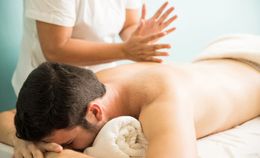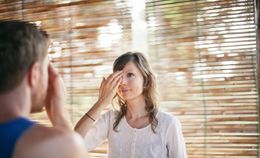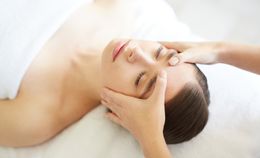If you have never tried acupuncture, your sense of what it involves is probably murky. But there's one element of acupuncture treatment you're probably familiar with: needles.
For many people, this essential tool of acupuncture treatment can feel mysterious, intimidating, maybe even a bit frightening. However, understanding more about the needles used in acupuncture treatment and how they contribute to boosting health and wellness is very reassuring for most people.
That's because, if your image of acupuncture needles is based on your experience of needles in conventional Western medicine - large and often painful when inserted - your ideas are (fortunately) way off!
Acupuncture needles are specialized tools used specifically in acupuncture treatment. They are very different from the needles used in hospitals to draw blood or inject a vaccine, for example. Most people experience no significant discomfort during acupuncture treatment; it is common for people to occasionally experience no physical sensation at all when an acupuncture needle is inserted.
Unfortunately, because many people misunderstand what acupuncture needles are really like, their fear of needles deters them from trying acupuncture treatment when it could benefit them. They consequently miss out on this powerful, ancient method for promoting healing and supporting holistic health and wellness.
Read on to gain an accurate picture of what acupuncture needles are like, how they are used during a treatment session and how they benefit patients.
The truth about acupuncture needles
What is an acupuncture needle?
Acupuncture needles come in a variety of sizes for use on different parts of the body. They vary in both diameter (gauge) and length. Modern acupuncture needles are extremely thin compared to any needle you might encounter in a conventional medical setting. They range in diameter from 0.12 mm to 0.35 mm, with 0.25 mm to 0.30 mm being the most common.1
For comparison, the diameter of a human hair is usually about 01. mm in diameter; a typical acupuncture needle is just two and a half to three times that size. A standard sewing needle is three to four times the diameter of an acupuncture needle. A standard needle used for injections in a medical clinic is about ten times the thickness of an acupuncture needle!2
Acupuncture needles are usually made of stainless steel and are sometimes coated in silicone. The handle can be metal or plastic.
Because acupuncture needles are so fine compared to standard injection needles, they are far less likely to carry bacteria into the skin. Professional acupuncturists also maintain strict sanitary conditions and protocols to prevent infection. In the U.S., the Food and Drug Administration regulates the use of acupuncture needles and only licensed practitioners may use them.3 In modern practice, sterilized disposable acupuncture needles are individually wrapped in hygienic packaging and used only once.
How needles are used in an acupuncture session
In addition to acupuncture needles being much finer than the medical injection needles you might be more familiar with, they are also generally inserted to a shallower depth. Acupuncture needles generally do not cause bleeding during insertion, treatment, or removal.
The method by which the acupuncture practitioner inserts the needles also ensures minimal discomfort. Needles may be placed inside a plastic tube which the acupuncturist can hold as they locate the intended acupuncture point on the patient's body. Once the point has been identified, the acupuncturist can quickly tap the needle down through the tube into the skin.4
During a typical treatment session, an acupuncturist inserts between five and twenty needles. The practitioner may manipulate the needles briefly after insertion, gently moving them in place or applying warmth or very mild electrical impulses (a technique called electroacupuncture). Usually the patient experiences no serious discomfort during treatment. Mild soreness from needle insertion may occur and should go away quickly after treatment.
The patient lies still and soon is left to relax for ten or twenty minutes. At this point, the needles are removed quickly and usually painlessly.
How acupuncture needles promote healing
Acupuncture is an ancient healing art that developed as a central practice in Traditional Chinese Medicine and is practiced as a complementary therapy to conventional Western medical treatment today.
In Traditional Chinese Medicine, a lack of harmony and balance can occur in the body as the result of psychological and physical stress. Over time this can lead to blockages and weakening in the flow of qi, the vital energy that flows in and around all living beings. As energy flows are disrupted or imbalanced, the person is likely to become more susceptible to illness and injury.
Acupuncture works by restoring balance and strength to energy flows, ensuring free flowing qi and improving the whole system's resilience and capacity to heal.5
During an acupuncture session, needles are inserted at strategic locations along the meridians, or energy pathways, to stimulate energy movement and restore balance. Some western medical researchers believe the needles also may promote healing by stimulating the nervous system, the immune system, and blood circulation, prompting the body to release natural pain-reducing chemicals called endorphins,6 and intervening in the way the body and mind experience pain.7
In any case, there is much clinical evidence supporting the safety and efficacy of acupuncture, both as a holistic treatment to promote overall health and wellness and as a complementary therapy to support patients suffering from a range of conditions.
Because acupuncture is used to promote the body's capacity for self-healing, it is a worthwhile treatment for a wide range of health conditions. Common reasons people seek acupuncture treatment include low-back pain,8 carpal tunnel syndrome,9 fertility problems,10 headaches, osteoarthritis, menstrual cramps, psychological distress, and for support during cancer treatment, among many other reasons.
Regular treatment is regarded as most effective, with a standard course including perhaps one or two sessions per week for four to six weeks.
The Bottom Line
Acupuncture is a safe and supportive wellness maintenance practice and a proven complementary therapy for patients with a range of health complaints and symptoms.
Although this healing art's use of needles may be an initial deterrent for some people, the truth is that acupuncture needles are fine, specialized devices that cause little discomfort and are in fact powerful tools for healing.
References:
1 From, Table 11.3: "An Introduction to Western Medical Acupuncture"
2 "Acupuncture Needle Size Comparison": https://wai-acupuncture.com/page/acupuncture-needle-size-comparison/
3 "Acupuncture": https://www.health.harvard.edu/medical-tests-and-procedures/acupuncture-a-to-z
4 "Demystifying the Needle": https://www.graceyhealth.com/demystifying-the-needle/
5 "What is Acupuncture?": https://wai-acupuncture.com/page/acupuncture/
6 "Slideshow: A Visual Guide to Acupuncture": https://www.webmd.com/pain-management/ss/slideshow-acupuncture-overview
7 "Acupuncture": https://www.health.harvard.edu/medical-tests-and-procedures/acupuncture-a-to-z
8 "Evidence of Efficacy of Acupuncture in the Management of Low Back Pain: a Systematic Review and Meta-analysis of Randomised Placebo- or Sham-controlled Trials": https://www.ncbi.nlm.nih.gov/pubmed/31526013
9 "Clinical Effectiveness of Acupuncture for Carpal Tunnel Syndrome": https://www.ncbi.nlm.nih.gov/pubmed/24707864
10 "Electroacupuncture Enhances Number of Mature Oocytes and Fertility Rates for In Vitro Fertilization": https://www.ncbi.nlm.nih.gov/pubmed/31624528















